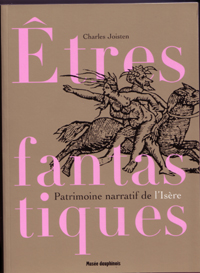Etres fantastiques. Patrimoine narratif de l’Isère
Musée dauphinois

- Auteur : Charles Joisten (1936-1981), Nicolas Abry, Alice Joisten
- Parution : 01/2005
- Nombre de pages : 576 pages, 18 x 24 cm
- Collection : Contes et êtres fantastiques
- Éditeur : Département de l'Isère
-
- Code produit : 1947
- ISBN : 2-905375-78-7
- € Prix : 40
-
- Etablissement : Musée dauphinois
-
Thème :
Patrimoine narratif
Pendant plus de vingt-cinq ans, depuis 1951, Charles Joisten a mené en Dauphiné et en Savoie des recherches intensives sur les traditions orales. C'est l'intégralité des récits recueillis dans le département de l'Isère, consacrés aux êtres fantastiques, qui est publiée ici. On y rencontrera des fées et autres êtres sauvages, l'esprit domestique des grosses maisons, des fermes et des granges (esprit follet, folleton, familier, servan, gonin…), le diable et ses suppôts-sorciers, magiciens, sorciers métamorphosés, loups-garoux, des animaux fantastiques dont le serpent-volant, des humains fantastiques avec les dames blanches ou demoiselles nocturnes, des revenants, des phénomènes lumineux, sonores ou matérialisés, sans oublier le monde foisonnant des croquemitaines, Gargantua, et tout un légendaire religieux, historique, relatifs à des trésors, etc. Les récits sont présentés par communes, celles-ci ayant été regroupées en huit territoires. Chacun pourra ainsi connaître les richesses de son propre pays et retrouver les thèmes de prédilection développés suivant les régions. Les thèmes véhiculés par ces récits transmis localement appartiennent cependant à un fonds commun narratif qui dépasse la région pour s'étendre à l'Europe et jusqu'au monde entier. Ce corpus dauphinois est donc relié au monumental catalogue international, le Motif-Index, l'insérant ainsi dans le patrimoine narratif de l'humanité. L'index des motifs par lequel se termine l'ouvrage apportera une vue d'ensemble des thèmes que les gens de l'Isère ont retenus dans leurs récits de tradition. During 25 years (since 1951), Charles Joisten accomplished a systematic survey of oral traditions in Dauphiné and Savoy. Today we are publishing the complete corpus of narratives dedicated to fantastic beings collected in the département of Isère. You will meet inside fairies and other wild people, the goblin attached to certain rich houses, farms or barns (esprit follet, folleton, familier, servan, gonin…), the devil and his fiends – sorcerers, magicians, witches, werewolves –, fantastic animals, like the flying snake, fantastic humans like "banshees", "the white lady" or night young ladies, haunting spirits or revenants, luminous, sounding or embodied phenomena. Without missing the crawling people of boggies, Gargantua the giant, together with all religious and historical legends, stories about treasures, etc. Narratives are presented by locality, which are grouped into eight small regions. Anybody will be able to recover the narrative heritage of her/his own homeland, and discover the recurrent themes and the mood of traditional beliefs that have been dwelling into these lands. The topics conveyed by such narratives transmitted locally belong however to a common narrative stock which extends farther than one place, far into other European countries and even worldwide. Thus our endeavour has been to link this corpus from Dauphiné to the impressive international catalogue, the Motif-Index, in order to include these sometimes very tiny pieces of memory into the untangible heritage of Humanity. The index at the end of this work will provide an overview of the mental matter that people from Isère kept in their traditional narratives. Charles Joisten (1936-1981). His masters in folklore were Arnold Van Gennep and Paul Delarue. He became curator at the Musée Dauphinois in Grenoble. In 1973 he founded the regional journal of Ethnology Le monde alpin et rhodanien. Nicolas Abry, PhD in Ethnology and Social Anthropology (Paris, EHESS, 1999). Since 2000, at Musée Dauphinois, where he has been working on database capture and indexing of the Joisten corpus of legends. Alice Joisten, music teacher, was a companion worker with her husband Charles Joisten in his fieldwork and she fostered the continuity of the ethnological journal he founded. She is now deeply involved in the divulgation of his data and scientific legacy.